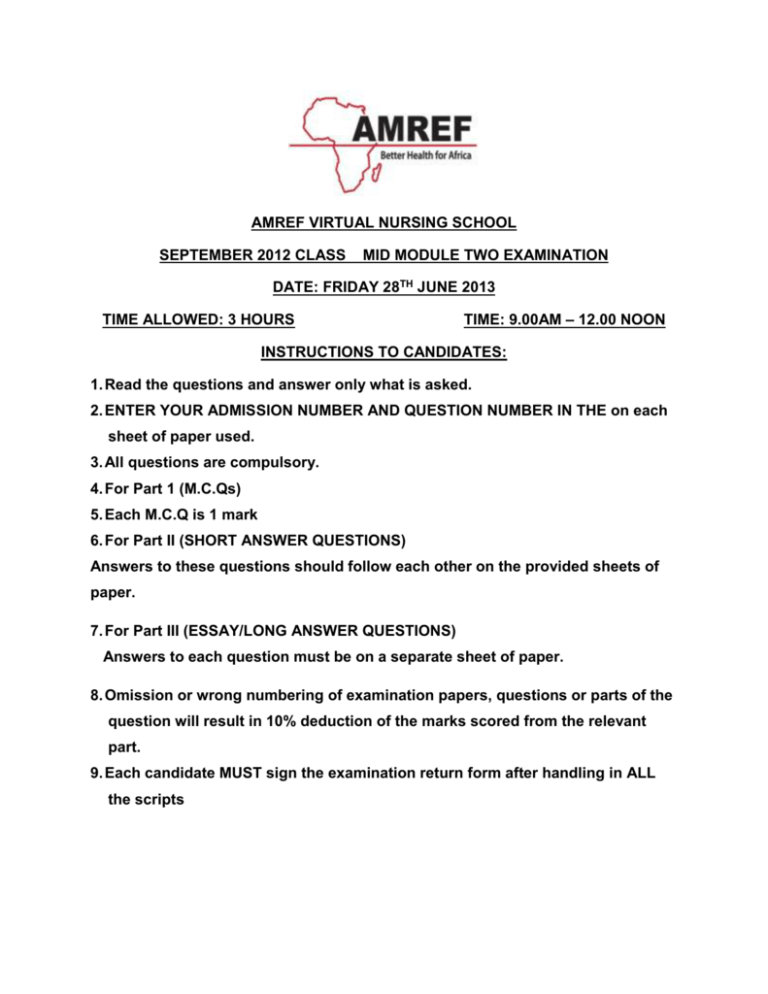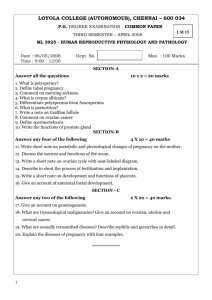Mid Module 2 - Amref Health Africa Training
advertisement

AMREF VIRTUAL NURSING SCHOOL SEPTEMBER 2012 CLASS MID MODULE TWO EXAMINATION DATE: FRIDAY 28TH JUNE 2013 TIME ALLOWED: 3 HOURS TIME: 9.00AM – 12.00 NOON INSTRUCTIONS TO CANDIDATES: 1. Read the questions and answer only what is asked. 2. ENTER YOUR ADMISSION NUMBER AND QUESTION NUMBER IN THE on each sheet of paper used. 3. All questions are compulsory. 4. For Part 1 (M.C.Qs) 5. Each M.C.Q is 1 mark 6. For Part II (SHORT ANSWER QUESTIONS) Answers to these questions should follow each other on the provided sheets of paper. 7. For Part III (ESSAY/LONG ANSWER QUESTIONS) Answers to each question must be on a separate sheet of paper. 8. Omission or wrong numbering of examination papers, questions or parts of the question will result in 10% deduction of the marks scored from the relevant part. 9. Each candidate MUST sign the examination return form after handling in ALL the scripts PART ONE: MULTIPLE CHOICE QUESTIONS (20 MARKS) 1. How frequently should the nurse assess uterine contractions during the second stage of labour. a. Every 5 minutes b. Every 15 minutes c. Every 30 minutes d. Every 60 minutes 2. A patient is in last trimester of pregnancy. The nurse should instruct her to notify her health care provider immediately if she notices: a. Blurred vision b. Hemorrhoids c. Increased vaginal mucus d. Shortness of breath on exertion 3. In the calendar-basal body temperature method of family planning, unsafe period for sexual intercourse is indicated by; a. Return preovulatory basal body temperature b. Basal body temperature increase of 0.1 degrees to 0.2 degrees on the 2nd or 3rd day of cycle c. 3 full days of elevated basal body temperature and clear, thin cervical mucus d. Breast tenderness and mittelschmerz 4. The following is contraindicated for a patient with a fourth-degree laceration following a precipitous delivery a. Applying cold to limit edema during the first 12 to 24 hours b. Instructing the client to use two or more peripads to cushion the area c. Instructing the client on the use of sitz baths d. Instructing the client about the importance of perineal (Kegel) exercises 5. A ultrasound for a client 14 weeks pregnant with gestational trophoblastic disease is likely to reveal a. An empty gestational sac. b. Grapelike clusters. c. A severely malformed fetus. d. An extrauterine pregnancy. 6. A client, 30 weeks pregnant, is scheduled for a biophysical profile (BPP) to evaluate the health of her fetus. Her BPP score is 8. This score indicate; a. The fetus should be delivered within 24 hours. b. The client should repeat the test in 24 hours. c. The fetus isn’t in distress at this time. d. The client should repeat the test in 1 week. 2 7. The following indicates progressive physiological change in postpartum period; a. Lactation b. Lochia c. Uterine involution d. Diuresis 8. When administering magnesium sulfate to a client with preeclampsia, the nurse understands that this drug is given to: a. Prevent seizures b. Reduce blood pressure c. Slow the process of labor d. Increase dieresis 9. The approximate time that the blastocyst spends traveling to the uterus for implantation is; a. 2 days b. 7 days c. 10 days d. 14 weeks 10. Functions of the prostate gland include; a. Synthesis of viscous fluid that keeps the sperms alive b. Production of a thin lubricating fluid c. Storage of spermatozoa d. Synthesis of testosterone 11. Presenting diameters in a well flexed head in a vertex presentation are the; a. Occipitofrontal, biparietal b. Sub-occipitobregmatic, biparietal c. Sub-occipitofrontal,bitemporal d. Mentovertical, bitemporal 12. Indicate whether the following statements are TRUE or FALSE a. The length of the baby’s breastfeeding session is determined by the quality of the attachment to the mother’s breast b. The fat content in breast milk is higher in colostrum than in mature milk 3 13. The insulin requirement of a diabetic mother after delivery should ideally be; a. Increased to prevent hyperglycaemia b. Decreased to prevent hypoglycaemia c. Withdrawn as the mother recovers spontaneously after birth d. Same as in pregnancy since carbohydrates metabolism increases after birth 14. In targeted postnatal care, the three postnatal checks are scheduled as follows; a. Within 24 hours, 2-4 weeks, 6th week b. Within 24 hours, 1-2 weeks, 6th week c. Within 48 hours, 1-2 weeks, 4-6 weeks d. Within 48 hours, 4-6 weeks, 6th month 15. Blood exchange transfusion is considered when the bilirubin levels are:a. 255UMOL (15mg.dL) for term healthy babies b. 400UMOL (23-29dL) for preterm babies c. 400-500UMOL(23-29mg/dL) for healthy term babies d. 140UMOL (5mg/dL) for preterm babies 16. A midwife examines the maternal surface of the placenta in order to: a. Ensure that the membranes are intact b. Determine completeness of lobes and abnormalities c. Confirm that the diameter is 20cm d. Ascertain sulci are well defined and placenta weighs 500g 17. Areas of concern in individual birth plan during ante-natal care include:a. Danger signs in pregnancy, identifying a birth partner during delivery diet b. Identifying true and false signs of labour, ensuring availability of funds for emergency, use of drugs c. Planning for transport, knowing when the baby is due, rest and exercise d. Identifying danger signs in pregnancy, identifying a birth attendant, knowing when the baby is due. 4 18. In clinical practice, a midwife may diagonise polyhydromnious by eliciting:a. Maternal complaint of breathlessness and discomfort, odema and varicosities of the vulva and lower limbs b. Uterus appearing smaller than expected gestational age; complaints of reduced fetal movements as pregnancy advance c. On abdominal palpation the fetal parts are easily felt, obstetric ultrasonography reveals renal abnormality d. Lecithin and sphyngomyelin ratio being <2:1; mental abdomen appearing unduly large of inspection 19. Erb’s palsy is a birth injury to the; a. Facial nerve b. Cervical plexus c. Lumbar plexus d. Brachial plexus 20. The five main bones in the vault of the foetal skull are; a. 1 occipital bone, 2 temporal bones, 2 parietal bones b. 2 temporal bones, 1 frontal bone,2 parietal bones c. 2 occipital bones,2 parietal bones,1 frontal bone d. 2 frontal bones, 2 parietal bones, 1 occipital bone 5 PART TWO: SHORT ANSWER QUESTIONS (40 MARKS) 1. Draw and label a diagram illustrating the cross-section of a lactating breast(5 marks) 2. State three (3) interventions that prevent mother to child transmission of HIV during labour. (3 marks) 3. State five (5) clinical features of placenta praevia (5 marks) 4. Outline four (4) causes of face presentation (4 marks) 5. State three (3) effects of pregnancy on the urinary tract (3 marks) 6. Outline four (4) contraindications for intra uterine contraceptive device. (IUCD) (4 marks) 7. Explain three (3) ways in which deep venous thrombosis can be prevented during puerperium (3 marks) 8. Describe the pathophysiology of pre-eclampsia. (5marks) 9. State five (6) interventions for a patient with septic abortion (5marks) 10. Outline three (3) specific nutritional counselling messages you will share with a client with gestational diabetes (3 marks) PART THREE: LONG ANSWER QUESTIONS (40 MARKS) 1. Mrs. Teraide arrives at the labour and delivery unit at a gestation of 34 weeks. She complains of abdominal pain with vaginal bleeding. On examination, you note decelerating fetal heart rate. a. Define ante-partum haemorrhage. (1 mark) b. State three (3) types of placenta abruption. (3 marks) c. Differentiate between placenta abruption and placenta praevia. (5 marks) d. Describe the management of Mrs. Teraide until discharge. ( 2 marks) 2. Baby Net is admitted to the newborn Unit with a diagnosis of pathological jaundice. a. State three (3) diagnostic criteria for pathological jaundice. (3 marks) b. Describe the management of baby Net until the condition is controlled. (12 marks) c. State five (5) side effects of phototherapy. (5 marks) 6








